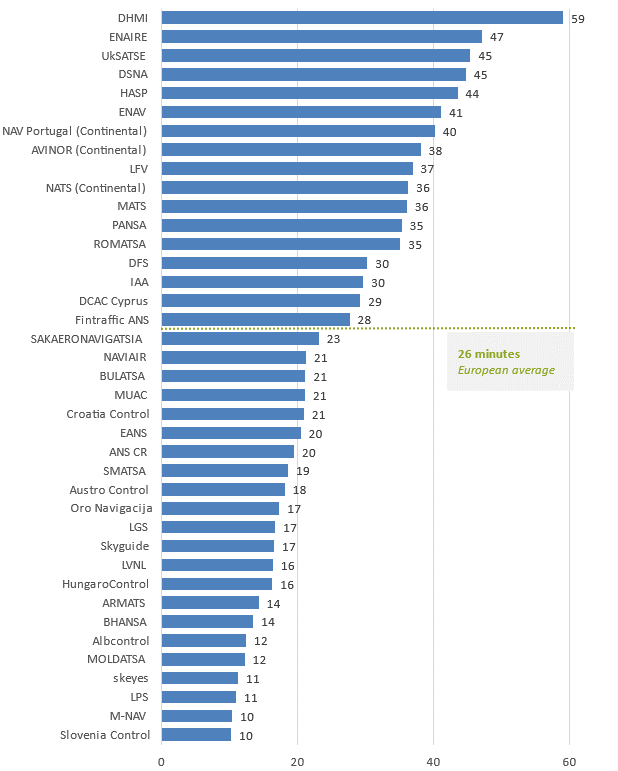| ANSP | Transit time (min) |
|---|---|
| Albcontrol | 12 |
| ANS CR | 20 |
| ARMATS | 14 |
| Austro Control | 18 |
| AVINOR (Continental) | 38 |
| BHANSA | 14 |
| BULATSA | 21 |
| Croatia Control | 21 |
| DCAC Cyprus | 29 |
| DFS | 30 |
| DHMI | 59 |
| DSNA | 45 |
| EANS | 20 |
| ENAIRE | 47 |
| ENAV | 41 |
| Fintraffic ANS | 28 |
| HASP | 44 |
| HungaroControl | 16 |
| IAA | 30 |
| LFV | 37 |
| LGS | 17 |
| LPS | 11 |
| LVNL | 16 |
| MATS | 36 |
| M-NAV | 10 |
| MOLDATSA | 12 |
| MUAC | 21 |
| NATS (Continental) | 36 |
| NAV Portugal (Continental) | 40 |
| NAVIAIR | 21 |
| Oro Navigacija | 17 |
| PANSA | 35 |
| ROMATSA | 35 |
| SAKAERONAVIGATSIA | 23 |
| skeyes | 11 |
| Skyguide | 17 |
| Slovenia Control | 10 |
| SMATSA | 19 |
| UkSATSE | 45 |
5 Transit time
5.1 EUROCONTROL Recommended Values
The transit time per ANSP represents the average time flown by aircraft controlled in its airspace over a year.@tbl-transit-time provides the average transit time (expressed in minutes) per ANSP in 2022. The data that was used to build this table, as well as the most recent data, can be accessed on the data section of the Aviation Intelligence Portal (which also contains data at ACC level).
This metric is the ratio between the total flight hours controlled and the IFR flights controlled, where:
Total IFR flight-hours controlled is the sum of the flight-hours controlled over the year by the ANSP. For a given flight, the flight-hours controlled are computed using information available in the Network Manager database as the difference between the exit time and the entry time in the controlled airspace.
IFR movements controlled is the number of flights that have been controlled ver the year by the ANSP as reported by EUROCONROL Performance Review Unit (PRU).
The data was recorded by the Network Manager for the 39 main ANSPs operating in Europe. In Figure 5.1, the range of transit time values for the ANSPs considered above can be observed. The European average in terms of flight time is 26 minutes per ANSP. A difference of 51 minutes between the highest (DHMI Türkiye) and the lowest (M-NAV North Macedonia and Slovenia Control) transit time can also be observed.

5.2 When to use the input?
This input is recommended for those projects where the flying time in a given ANSP is key to the assessment. As an example, it has previously been used for several CNS-related studies, in particular when studying the cost of communication services that depend on connection times.